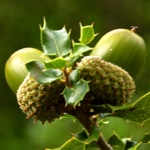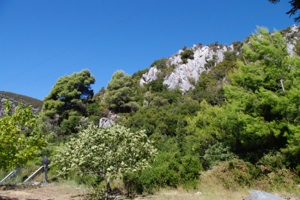Quercus coccifera
Kermes oak Πρίνος, Πουρνάρι

Fagaceae - Beech Family Dicot
Quercus coccifera
Kermes oak Πρίνος, Πουρνάρι

Fagaceae - Beech Family Dicot
Kermes oak is a plant which is ideally suited to life on a Greek island. It can grow as a small tree from a crack in the rock even in the barest surroundings but in response to sun, drought and nibbling by goats, it will develop into a low bush with thickened, prickly leaves.Although on Skopelos it is usually found as a shrub or small tree, a wonderful large Q. coccifera tree creates shade over the tiny church of Ag.Nicolaos in Karya.
The kermes oak was historically important as the insect kermes ilicis, found on the plant produced a bright red dye which was valued over centuries from the ancient Egyptians until the the middle ages.
1. COLOUR. Travels through the Paintbox. Victoria Finlay. 2002. Hodder and Stoughton. London.


Kermes "From its Sanskrit name, krim-dja, came the words carmin and crimson."1
"Dioscorides described how kermes was harvested with the fingernails - scraped carefully from the scarlet oak it lives on."1

Differentiation and fertilisation
In moister sites it is a softer more lush plant which along with the closely related Quercus ilex, forms dense thickets. In this situation it can sometimes be difficult to differentiate the two oaks and it is probable that cross fertilisation occurs and intermediate forms develop. The acorns of Quercus coccifera have sharp spreading spines and a small terminal spike. The leaves are variable in size and they may or may not have spines, they are always hairless.
Q. coccifera acorns are always spiny.